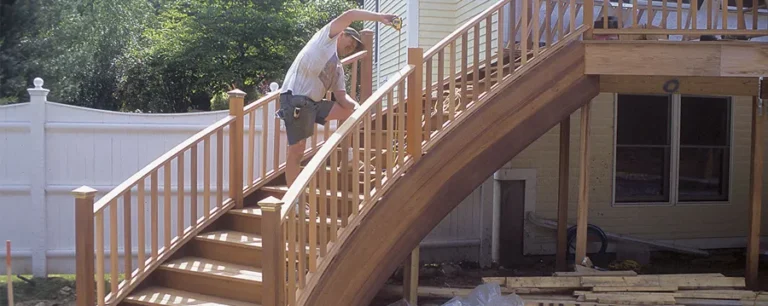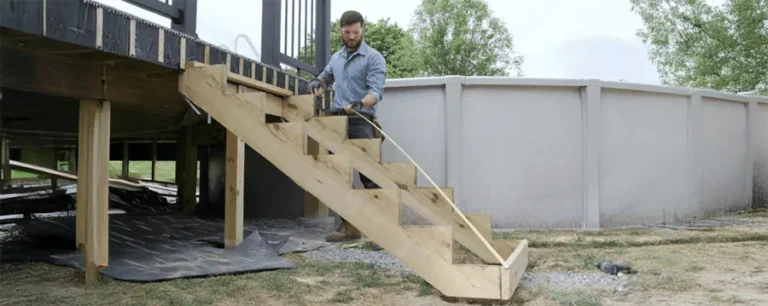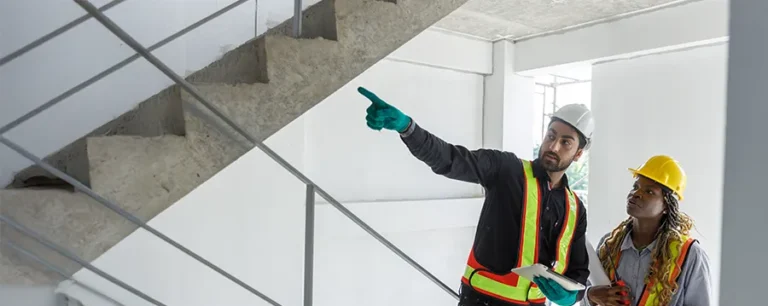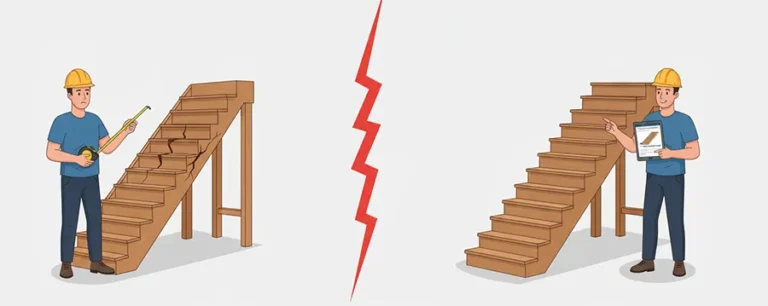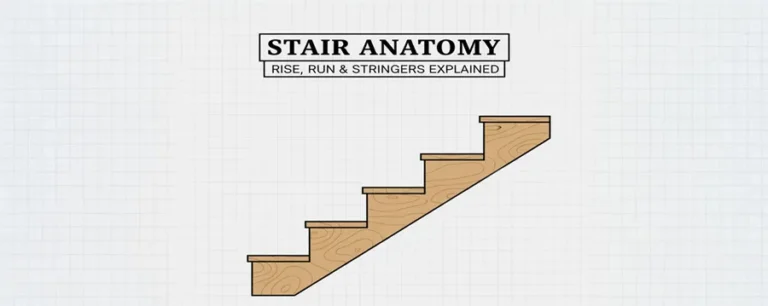Pro’s Guide to Lumber for Stair Stringers and Treads
Introduction
Every staircase is only as good as the materials beneath your feet. Choosing the right lumber for your stair stringers and treads is a balance of strength, durability, aesthetics, and cost. In this guide we will walk through what professional builders look for in wood selection, structural criteria you must meet, best species for treads and stringers, protecting against wear and moisture, and how a stair calculator tool can assist your design. (If you prefer, we can perform the structural layout for you using our stair calculator.)
Why Material Choice Matters for Stairs
Stair stringers are the backbone. They carry the loads from treads, risers, and user traffic. Poor choice or undersized wood can sag, crack, or fail over time. Treads bear direct foot traffic, so they must resist wear, dents, and impact. A well chosen wood extends life, lowers maintenance, and improves safety and appearance.
Essential Criteria for Stair Lumber
Before species selection, the wood must satisfy:
- Structural strength and stiffness, enough bending strength, modulus of elasticity, no weak knots or defects.
- Dimensional stability, wood that resists warping, cupping, or twisting.
- Wear resistance and hardness, especially for treads in high traffic zones.
- Moisture and decay resistance, especially for outdoor or humid environments.
- Workability and finishability, ability to plane, route edges, accept stains or paints.
Choosing Lumber for Stringers
The stringers are structural and often hidden, so appearance is secondary to strength. Here are good options and considerations:
Common species and engineered alternatives
- Pine (dimensional pine or structural grade), cost effective, easy to work, acceptable in many home applications if sized correctly.
- Douglas fir or fir-pine mix, excellent structural capability, commonly used in framing lumber.
- LVL, PSL, or glulam beams, engineered members that resist warping, often used in higher load or long span staircases.
Guidelines in sizing and layout
- Ensure the thickness and depth of the stringer section meets code or design loads, check local building codes for allowable spans.
- Use full depth stringers or cut stringers depending on design, avoid overcutting that weakens the beam.
- Double stringers may be required for wide stairs or high loads.
- Provide proper bearing at top and bottom supports to avoid concentration stresses.
Choosing Lumber for Treads (and Risers)
Treads are the visual and functional face of the staircase. Here is how to choose wisely:
Top recommended hardwood species
The following are frequently used by professionals:
- White Oak, durable, water resistant, tight grain, often a top pick.
- Red Oak, more abundant, good hardness, warmer tones.
- Maple, lighter aesthetic, good hardness, clean grain.
- Hickory or Ash, extremely tough, standout grain variation.
- Walnut, Cherry, and select exotics, premium aesthetics, somewhat softer, useful for accent treads.
Painted riser grade options
For risers that will be painted, not stained, many builders choose poplar, primed pine, or MDF. Poplar is commonly used because it accepts paint well and is lower cost.
Thickness, depth, and edge design
- A nominal 1 inch, or more, solid thickness is common for hardwood treads, thicker for high wear or wide spans.
- Tread depth, run, is often 10 to 11 inches, or more in some codes.
- Include a nosing or bullnose rounded front edge for safety and comfort.
Moisture, Finishing, and Protection
Even the best wood can fail if exposed to moisture or excessive extremes. Here are best practices:
- Acclimate lumber in the jobsite environment for days or weeks to reduce warping or shrinkage.
- Seal all sides, underside and edges, before installation to limit moisture absorption.
- Use a protective finish, tough polyurethane, conversion varnish, or shellac as applicable.
- In humid or outdoor settings, choose species or treated wood rated for exposure, or use exterior grade hardwood.
- Maintain periodically, inspect for cracks, refinish surface before wear becomes damage.
Structural Safety and Code Considerations
Even the best wood fails if undersized or improperly laid out. Key points:
- Follow local building code for maximum riser height, minimum tread width, and nosing requirements.
- Check deflection limits, under load, the tread plus stringer should not sag noticeably.
- Ensure proper fastening, toe screws, adhesives, hidden fasteners, to prevent squeak or separation.
- Use glue blocks or support blocks as needed under wide treads to avoid flex. Often a 2×2 support under the tread over riser contact helps reduce movement.
How a Stair Calculator Tool Helps You Plan Accurately
Manual calculations of rise, run, number of steps, and stringer geometry are error prone. A dedicated stair calculator helps you:
- Compute the ideal riser and tread dimensions based on your total rise and run constraints.
- Lay out the stringer cut pattern precisely, minimizing waste and error.
- Check code compliance automatically, angle limits and consistency of risers.
- Adjust schemes iteratively and visualize how many steps or landings you will need.
If you prefer not to wrestle with geometry, we can perform the layout for you using the same stair calculator, giving you cut patterns and lumber lists to grab and build confidently.
Comparisons and Tradeoffs Summary
| Priority | Best Choices or Notes | Tradeoffs or Cautions |
|---|---|---|
| Durability and wear resistance | White oak, hickory, ash | More expensive, harder to machine |
| Cost efficiency | Red oak, maple | Slightly softer, more visible wear over long term |
| Painted surfaces | Poplar, primed grade pine | Not as durable under bare foot or heavy scuffing |
| Moisture exposure | Exterior grade hardwoods, treated woods | Must maintain seal and finish |
| Structural stringer support | LVL, engineered beams, Douglas fir | Higher cost, needs proper design |
In many mid range homes, red oak treads on pine or fir stringers is a common balance. In luxury or custom builds, walnut or exotic hardwoods add standout visual appeal.
Installation and Best Practices Tips
- Dry fit stringers, risers, and treads before final assembly to confirm alignment and fit.
- Pre drill for screws to avoid splitting, especially near ends.
- Use glue and mechanical fastening to minimize squeaks.
- Maintain consistent riser heights, variation of more than 1/8 inch can feel awkward or unsafe.
- Ensure the nosing is consistent and secure, overhang should not be excessive, often 3/4 inch to 1 1/4 inches.
- When finishing, sand progressively, for example 120 to 180 to 220 grit, and apply multiple coats of protective finish, allowing cure times fully between coats.
Common Questions (People Also Ask)
Is pine okay for stair treads?
Pine is cost effective and workable, but it is softer and more prone to dents and wear. In lower traffic settings, or where it is painted or carpeted, pine can suffice, but it may require more maintenance.
Should my stair treads match my floor wood?
Matching species or stain gives visual continuity. You may also choose a complementary species or grain to highlight the staircase. The key is color harmony and finish matching.
How thick should stair treads be?
Solid hardwood treads are often 1 inch nominal, 3/4 inch actual or more, and thicker options, 1 1/4 inches or 1 1/2 inches, provide extra durability and reduce deflection.
Can I use engineered wood treads?
Yes. Engineered hardwood or plywood cores with hardwood veneer can be used if properly rated. They reduce movement and can resist warping better in variable humidity. Ensure the thickness and veneer wear layer is adequate.
What if I already have stringers and want to overlay new treads?
You can overlay hardwood treads over an existing structural substrate, plywood or OSB, as long as the underlying structure is sound and you can maintain consistent riser and tread heights.
Conclusion and Next Steps
Selecting lumber for stair stringers and treads is a decision that impacts durability, safety, aesthetics, and long term maintenance. Use strong, stable species for stringers, or engineered alternatives, and durable hardwoods for treads, while using paint grade materials only where finishes conceal wear. Use the Stair Calculator to validate your layout and reduce mistakes. If you like, we can carry out the full design for you, cut list, templates, geometry, using our stair calculator system. Build confidently with the right materials and a solid plan beneath your feet.

